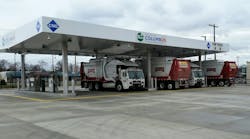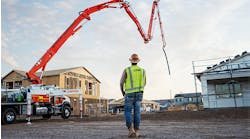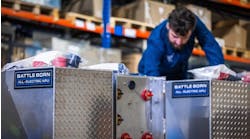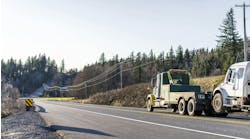Many fleets seek alternative fuel vehicles as a way to reduce fuel cost and improve their environmental footprint. And while that is true, what they don’t consider is the added costs related to alternative fuel vehicles. In the case of natural gas power, those added costs can include upgrades to maintenance facilities, the cost to both add and maintain infrastructure such as fueling stations, and even costs related to vehicle maintenance.
That’s why the city of Columbus, OH, sought a partner to help with its transition to natural gas power. That partner, Marathon Corp., has expertise in designing and building compressed natural gas fueling stations.
Bill Burns, fleet operations manager for Columbus, and Rob Adams, principal of Marathon, held court during a session at the Green Truck Summit in Indianapolis back in March. The pair spoke of the Columbus CNG project and offered attendees advice before making the leap themselves.
“We didn’t have an expert in-house, so we relied on [outside] experts,” Burns added. According to Burns, the city had to address five key questions before it made the decision to install CNG fueling stations (Columbus has two such stations): What does it take to switch to CNG? Where do we find experts in CNG? What vehicle specs do we need? What facility upgrades were needed? What fueling infrastructure was needed?
Columbus, which added its first CNG refuse truck in 2009, is primarily fueling its vehicles in the morning and evenings. This meant that traffic at the stations was slow during the day, so the decision was made to open the $3.2 million stations to the public, Burns said. The city sells CNG to the public at cost as city regulations do not allow it to make a profit off the fuel, he explained.
“Columbus has picked up a lot of [Class 8 day cab] traffic because the station is easy to access and designed to accept tractor-trailers,” Adams said.
In fact, Burns added, nearly 50% of the CNG at the two stations is used by non-city vehicles.
The cost to upgrade its facilities to handle CNG vehicle maintenance cost about $660,000, Burns said. Columbus has about 139 CNG vehicles in its city fleet of 6,300 vehicles and other equipment. Forty-eight of those vehicles are refuse trucks with another 24 on order.
“We’ll continue with our CNG surge with refuse trucks until they are 100% CNG,” Burns said. “We estimate that by 2020, we’ll have over 440 CNG cars and trucks in the city fleet.
“Refuse trucks are our low-hanging fruit as [diesel-powered ones] get about 3 mpg,” Burns added. “However, we’ve taken the position that since we are investing in the CNG fueling infrastructure, nearly all new vehicle purchases will be dedicated CNG vehicles to maximize our capital investment.”
Adams added some tips for anyone looking to invest in natural gas. The first is to know the size of the facility and gas pressure. Larger facilities and lower gas pressure increase costs as larger compressors are needed to fuel vehicles.
“Take the average consumption per day for the vehicles you will be fueling, then look at [the time of day] you will be fueling” to determine the size of the station needed, Adams said. “And negotiate for high gas pressure. Higher pressure reduces capital costs of equipment because you don’t need to buy a [larger] piece of equipment to get the fuel out.”
Higher pressure can also lower maintenance costs on the fueling station and compressor. Design stations to be scalable, he advised. This will allow fleets to add vehicles without the need to build a new facility.
You need to have a vehicle specification because not all CNG vehicles are created equal, Adams said. The CNG capacity needed on board the vehicles must be considered as well.
Another tip offered by Adams, particularly for a station that will be open to the public, is to install an extra compressor. “It’s not if a compressor will break down, it’s when,” he said. Also, install a backup generator in case of a power outage.



